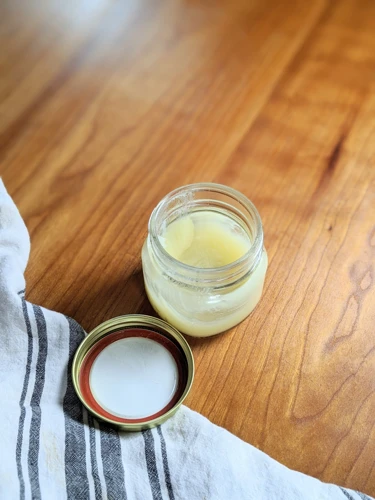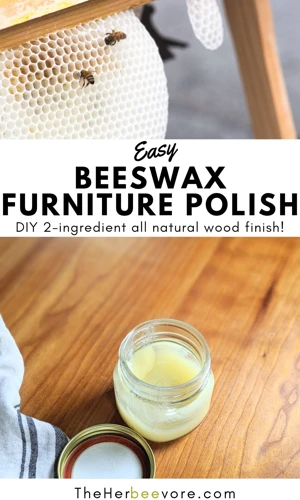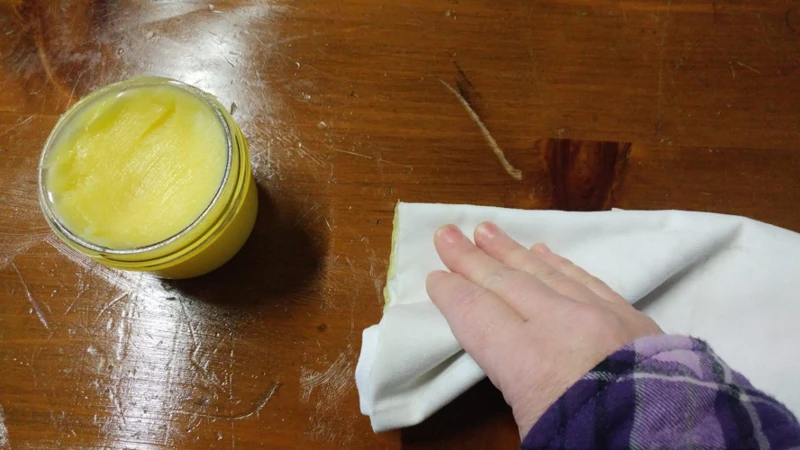Have you ever noticed how much more appealing wooden furniture looks when it’s polished? Perhaps you’ve already tried numerous commercial polishes, only to end up with unsatisfactory results. Well, worry no more as there is a natural solution that’s easy to make and highly effective: beeswax polish. Not only will it help your furniture look better than ever, but it will also protect it from damage caused by dust, sunlight, and humidity. Below, we’ve compiled a step-by-step guide to making beeswax polish at home using only a few simple ingredients. Let’s get started!
Why Use Beeswax Polish?

When it comes to home maintenance, most people usually overlook polishing their furniture. However, incorporating a simple step such as polishing can do wonders to improve the aesthetics of the house. Beeswax polish is an excellent and cost-effective solution to bring back the shine and protect wooden furniture from dust and scratches. Not only does it enhance the natural beauty of the furniture, but it also maintains its durability. In the following section, we’ll explore the advantages of using beeswax polish over conventional furniture polish. If you want to learn more about beeswax polish benefits or tips on how to store it, check out our articles Beeswax Polish Furniture Benefits and Beeswax Polish Storage Tips.
Benefits of Beeswax Polish
Using beeswax polish on your furniture, floors, and other wooden items can offer numerous benefits. Here are some of the most notable benefits of using beeswax polish:
- Protects against moisture: Beeswax polish forms a protective barrier on wooden surfaces, preventing moisture from penetrating the wood. This can help prevent warping, cracking, and other types of damage caused by excess moisture.
- Enhances the natural beauty of the wood: When applied correctly, beeswax polish can enhance the natural beauty of the wood, bringing out the rich colors and textures that make each piece unique. It can also restore the shine and luster of older pieces.
- Repels dust and allergens: Beeswax polish creates a surface that repels dust, dirt, and other allergens, making cleaning and maintenance easier.
- Can be used on many surfaces: Beeswax polish is versatile and can be used on a variety of surfaces, including furniture, floors, cutting boards, and even leather. This makes it a great all-purpose solution for many different types of households.
- Easy to make: Making beeswax polish at home is a simple and affordable way to benefit from these advantages. All you need are a few basic ingredients and some simple kitchen tools to get started.
These benefits make beeswax polish a great option for anyone looking to protect and enhance their wooden items. If you want to learn more about the benefits of beeswax polish, check out our article on tips for using beeswax polish, or our guide on how to make your own beeswax furniture polish at home.
What You’ll Need

Before you start making beeswax polish at home, it’s important to gather all the necessary supplies. Here’s what you’ll need:
1. Beeswax: This is the main ingredient in the polish, and it’s what gives it its natural shine and protective qualities. You’ll need about 1 cup of shaved or grated beeswax to make a decent amount of polish.
2. Oil: You’ll need a carrier oil to mix with the beeswax. Many prefer to use jojoba oil, but you can also use coconut oil, olive oil or any other vegetable oil that you have. You’ll need about 2 cups of oil for every 1 cup of beeswax.
3. Double boiler or a makeshift one: A double boiler is a pot that sits on top of another pot of boiling water. You can also create a makeshift one by using a heatproof bowl and placing it over a pot of boiling water. This is the best way to melt the beeswax slowly and evenly without scorching it.
4. Stirring tool: You’ll need a kitchen tool to stir the beeswax and oil together. A wooden spoon is ideal for this.
5. Container: You’ll need a container to store the finished polish. A glass jar with a tight-fitting lid works well.
6. Essential oil (Optional): If you want to add a pleasant scent to your polish, you can use a few drops of essential oil. This is optional and is purely for fragrance purposes.
By gathering all of these supplies, you can be sure that you have everything you need to make the beeswax polish successfully. Using your homemade beeswax polish will create a protective and natural layer on your furniture. If you need more information about beeswax choice and benefits, check our article on beeswax wood furniture polish.
Step-by-Step Instructions

Now that you have all of the necessary ingredients and tools, it’s time to start making your own beeswax polish! Follow the simple steps below to create a natural, eco-friendly polish for your wooden furniture and other items that need a bit of care. Don’t worry, you don’t need to be a DIY expert to do this, even if you’re a beginner, the step-by-step guide will make the process easy to understand and follow. So, grab your ingredients and let’s get started!
Step 1: Grate the Beeswax
Before starting the process of making beeswax polish, the first step is to grate the beeswax. This is an important step as it will help the beeswax to melt quickly and evenly.
What You’ll Need:
| 1. | A block of beeswax |
| 2. | A grater |
To begin, take the block of beeswax and place it on a flat surface. Hold the block of beeswax firmly with one hand and use the grater with the other hand to shave off small pieces of wax. It is important to use a grater that is clean and free from any debris or rust.
Tips:
– Grating the beeswax can be a time-consuming process, so it is recommended to use a grater with larger holes to make it faster and easier.
– It is important to use a sharp grater to make the task easier and reduce the risk of accidentally cutting yourself.
– If the block of beeswax is too large to hold comfortably, you can use a knife to cut it into smaller pieces before grating it.
Once you have finished grating the beeswax, you can move on to the next step of melting the wax.
Step 2: Melt the Beeswax
To continue making beeswax polish, step 2 is to melt the grated beeswax. The beeswax can be melted using a double boiler or in a microwave.
Here are the two methods:
| Method | Instructions |
|---|---|
| Double Boiler |
|
| Microwave |
|
Regardless of which method you choose, be sure to never leave the melting beeswax unattended. Keep a fire extinguisher nearby in case of any accidents. Once the beeswax has melted completely, it is time to move on to the next step of adding the oil.
Step 3: Add the Oil
Once your beeswax is fully melted, it’s time to add the oil. The oil helps to make the beeswax polish more pliable and easier to apply. Here are the steps to follow when adding the oil:
- Choose your oil: you can use any type of oil, such as olive oil, coconut oil, or jojoba oil. Each oil has its own unique properties, so choose the one that best suits your needs. For example, olive oil is known for its moisturizing properties, while coconut oil is more lightweight and less greasy.
- Measure out the oil: for best results, use a ratio of one part beeswax to three parts oil. Make sure to weigh or measure the oil accurately to ensure the correct ratio.
- Add the oil to the melted beeswax: slowly pour the oil into the melted beeswax, stirring constantly. Be careful not to add the oil too quickly, as this could cause the mixture to separate. Stir the mixture until combined.
- Continue heating the mixture: keep the mixture on low heat for about 5-10 minutes, stirring occasionally. This will help to fully incorporate the oil and beeswax.
It’s important to note that the type and amount of oil you use will affect the texture of your beeswax polish. If you want a softer polish, use more oil. If you want a harder polish for furniture, use less oil. Experiment with different ratios and types of oil to find what works best for your needs.
Step 4: Stir in the Essential Oil (Optional)
Adding essential oils to your beeswax polish is optional, but can provide a pleasant scent and additional benefits depending on the oil you choose. Some popular options include lavender for its calming properties, lemon for its fresh scent and antiseptic properties, or tea tree for its antibacterial and antifungal properties.
To incorporate essential oils into your polish, follow these steps:
| Step 1: | Melt the beeswax and oil mixture if it has solidified. |
| Step 2: | Add a few drops of your desired essential oil into the mixture. Start with a small amount and add more as needed – a little bit goes a long way! |
| Step 3: | Stir the mixture thoroughly to distribute the essential oil evenly. You can use a whisk or fork to do this. |
It’s important to note that some essential oils may have different effects depending on their concentration or if they are used neat (undiluted). Always do your research and use caution when adding essential oils to your beeswax polish, especially if you will be using it on items that come into contact with your skin.
Using Your Beeswax Polish
Once you have made your own beeswax polish, you’ll want to put it to use. But how do you actually use it? We’ve got you covered with some helpful tips and tricks for using and maintaining your homemade beeswax polish. From application techniques to maintenance instructions, read on to learn how to get the most out of your natural and eco-friendly furniture polish.
Application
Applying beeswax polish is a simple process, but there are a few things to keep in mind to ensure the best results. Here is a step-by-step guide for applying your homemade beeswax polish:
| Step | Description |
|---|---|
| 1 | Clean the Surface: Before applying the polish, make sure the surface you want to treat is clean and dry. Use a soft cloth to remove any dust or dirt. |
| 2 | Apply the Polish: Using a clean, soft cloth, apply the beeswax polish to the surface in a thin, even layer. Work in small sections, using a circular motion. Avoid applying too much polish, as this can result in buildup and may make the surface cloudy. |
| 3 | Let it Sit: Allow the polish to sit on the surface for a few minutes. This will give the oils a chance to penetrate and nourish the wood. |
| 4 | Buff: Using a clean, dry cloth or buffing brush, buff the surface in a circular motion. This will remove any excess polish and help to bring out a beautiful shine. |
| 5 | Repeat (Optional): Depending on the condition of your surface, you may wish to repeat the process a few times for optimal results. Allow each layer to dry completely before applying the next one. |
By following these simple steps, you can achieve a beautiful, natural-looking finish that will protect and nourish your wood surfaces for years to come. Remember to store your homemade beeswax polish in a cool, dry place and to use it regularly to keep your surfaces looking their best.
Maintenance
Once you’ve applied the beeswax polish to your desired surface, it’s important to maintain it properly to ensure longevity and sustained shine. Here are a few tips for maintaining your beeswax polish:
| 1. | Avoid exposing the surface to excessive moisture or direct sunlight, as these can cause the polish to wear off more quickly. |
| 2. | To keep the surface looking its best, periodically buff the surface with a soft cloth or brush to remove any dust or debris that has accumulated. This will also help maintain the shine and smoothness of the surface. |
| 3. | If the surface begins to look dull or worn, simply reapply the beeswax polish using the same step-by-step instructions listed above. This should restore the surface to its original shine and protect it from future wear and tear. |
By following these maintenance tips, you can ensure that your beeswax polish lasts as long as possible and keeps your surfaces looking beautiful.
Conclusion
In conclusion, making your own beeswax polish at home is a simple and rewarding process that can provide numerous benefits for your wooden furniture, floors, and household items. By using natural ingredients and avoiding harsh chemicals found in commercial polishes, you can protect and maintain the beauty of your wooden possessions while also being environmentally conscious.
Not only does beeswax polish provide a protective layer for your wooden items, but it also brings out the natural beauty of the wood grain. The oils in the polish create a rich, deep shine that enhances the colors and patterns of the wood. Plus, the sweet, honey-like aroma of beeswax adds a pleasant scent to your home.
By following the step-by-step instructions outlined in this article, you can easily make your own beeswax polish using just a few simple ingredients. Once you have created your polish, remember to apply it sparingly and with a gentle touch, as a little bit goes a long way.
Regular maintenance is key to keeping your wooden items looking their best for years to come. Dusting and wiping down with a soft cloth will help prevent scratches and damage. Use your beeswax polish on a monthly basis to restore and maintain the protective layer and shine of your wooden items.
In conclusion, making your own beeswax polish is a simple and affordable way to protect, beautify, and extend the life of your wooden furniture, floors, and household items. With a little bit of time, effort, and love, you can enjoy the many benefits of beeswax polish in your home.
Frequently Asked Questions
Can beeswax polish be used on all types of furniture?
Beeswax polish is safe to use on all types of furniture, including antiques and modern pieces.
What kind of oil should I use for the polish?
You can use any type of natural oil, such as olive oil, jojoba oil, or coconut oil.
Do I need to use essential oil for the polish?
No, adding essential oil is optional, but it can add a pleasant scent to the polish.
How long does it take for the polish to dry?
The polish dries quickly, within a few minutes of application.
How often should I use beeswax polish?
It is recommended to use the polish once every few months to maintain the shine and protect the furniture.
Can the polish be used on other surfaces besides furniture?
Yes, beeswax polish can be used on leather products, musical instruments, and even cars.
Does beeswax polish protect against water damage?
Yes, beeswax polish creates a protective layer on the surface of the furniture, making it more resistant to water damage.
How long does the polish last?
The polish can last for several months, but it may need to be reapplied if the furniture is used frequently.
Will the polish change the color of my furniture?
Beeswax polish may darken the color of the furniture slightly, but it will not drastically change the color.
Is beeswax polish safe for pets and children?
Yes, beeswax polish is made from natural ingredients and is safe for pets and children.
